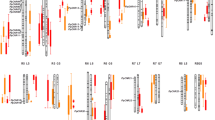Summary
A survey was made of the sweetness and sourness of the fruits of apple cultivars. Measurements of the concentration of sugars and malic acid in ripe fruits were made and the variation between samples of a cultivar, between cultivars, between years and between cultivars and their tetraploid and colour sports was studied and showed a wide range of variation between cultivars but fairly constant values within cultivars.
The study of a number of progenies shows that sweetness and sourness are inherited independently. Sweetness shows a quantitative pattern of inheritance and the progeny mean approximates the mid-parent value. Sourness is controlled by a single gene, with medium and high acidity being dominant to very low, superimposed on a quantitative pattern.
The mean sugar and acid concentrations of a progeny and the approximate range of variation can be predicted from the sugar and acid concentrations found in the parents.
Similar content being viewed by others
References
ArchboldH. K., 1928. Chemical studies in the physiology of apples IX. Ann. appl. Bot. 13: 541–566.
ArchboldH. K., 1932. Physiology of apples XII. Ripening processes in the apple and the relation of time of gathering to the chemical changes in cold storage. Ann. Bot. 46: 407–459.
BeesterA., WoodM. W., & WahlinC. S., 1925. Carbohydrate studies I. The relative sweetness of pure sugar. Am. J. Physiol. 73: 387–396.
BrownA. G., 1960. The inheritance of shape, size and season of ripening in progenies of the cultivated apple. Euphytica 9: 327–337.
Brown, A. G., 1962. Comparative sweetness of various apples. 53rd A. Rep. John Innes Institute pp. 9–10.
HumeA. C. & WooltortonL. S. C., 1957. Organic acid determination of apple fruits: changes in individual acids during growth. J. Sci. Fd Agric. 8: 117–122.
HumeA. C. & WooltortonL. S. C., 1958. Determination and isolation of the non-volatile acids of pome fruits and a study of acid changes during storage. J. Sci. Fd Agric. 9: 150–158.
JordanC., KorteF. & SengbuschR.von, 1957. Die papier chromatographische Bestimmung der einzelnen Saüre-und Zuckerarten als Grundlage für die Auslese auf Wohlgeschmack bei Obst, Beerenobst und Gemüse. Züchter 27: 69–76.
LuggJ. W. H. & OverellB. T., 1947. Partition chromatography of organic acids on a paper sheet support. Nature, Lond. 160: 87–88.
MoncriefR. W., 1951. Chemical Senses. Leonard Hill, London.
NybomN., 1959. On the inheritance of acidity in cultivated apples. Hereditas. 45: 332–350.
Stackenbrock, K. H., 1962. The effect of environment on the aroma of the apple. Rep. Eucarpia Conf. (1961) p. 50–56.
VisserT., SchaapA. A. & deVriesD. P., 1968. Acidity and sweetness in apple and pear. Euphytica 17: 153–167.
WilliamsW. & BrownA. G., 1956a. Genetic response to selection in cultivated plants; Gene frequencies in varieties of Prunus persica. Proc. R. Soc. B. 145: 337–347.
WilliamsW. and BrownA. G., 1956b. Genetic response to selection in cultivated plants; Gene frequencies in Prunus avium. Heredity. 10: 237–245.
Author information
Authors and Affiliations
Rights and permissions
About this article
Cite this article
Brown, A.G., Harvey, D.M. The nature and inheritance of sweetness and acidity in the cultivated apple. Euphytica 20, 68–80 (1971). https://doi.org/10.1007/BF00146776
Received:
Issue Date:
DOI: https://doi.org/10.1007/BF00146776




